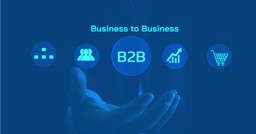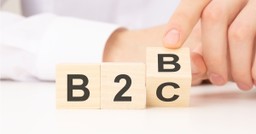Ever found yourself pondering the key differences between B2B and B2C advertising? You’re not alone.
In the vast world of digital marketing, understanding the nuances between these two markets can be the difference between a successful campaign and a missed opportunity.
Let’s embark on this journey together, shall we?
The Foundational Differences Between B2B and B2C Markets
Before we dive deep, let’s set the stage by understanding the core differences between B2B and B2C markets. Trust us; this will be your guiding star as you navigate the advertising galaxy.
Buying Cycle Complexity
Every purchase, be it a pen or a software suite, has a story behind it. Let’s unravel that story.
- Length of the buying cycle: Did you know that B2B companies usually have a longer sales cycle? It’s true! B2B purchases usually involve more research, evaluations, and approvals. Think about it: you might spend weeks or even months deciding on software for your company, but only a few hours to decide on a new pair of shoes.
- Decision-makers involved: Here’s a fun fact: B2B decisions often involve a committee. From the CEO to the intern, everyone might have a say. On the flip side, B2C decisions are usually solo acts driven by individual preferences.
- Emotional vs. Rational buying process: While that new pair of shoes might tug at your heartstrings (hello, B2C emotional buying!), business-to-business purchases are more like Spock from Star Trek – logical and rational.
- Purchasing frequency and volume: B2C consumers often shop ’til they drop, making frequent, smaller purchases. B2B clients? They’re more about those big, once-in-a-blue-moon bulk buys.
- Price points: B2B products or services often come with a heftier price tag than Business-to-consumer offerings. That makes sense, right? After all, a company-wide software license costs a tad more than a cup of coffee.
Audience Scope and Segmentation
Pop quiz! Who are you targeting with your ads? Let’s break it down.
- B2B targets specific industries or companies: Picture this: you’re an advertiser aiming for the stars, targeting specific industries or even individual companies. That’s B2B for you!
- B2C targets broad demographics and interests: B2C is like casting a wide fishing net, hoping to catch as many fish as possible based on shared interests or demographics.
- Granularity of audience segmentation: Here’s a nugget of wisdom: B2B segmentation is like using a microscope, zooming in on specific job roles or departments. B2C? It’s more like binoculars, looking at the broader landscape.
- The role of personalization in targeting: Personalization is the name of the game in both markets. But while B2B might tailor messages for a specific industry, B2C dances to individual consumer whims and fancies.
- Geographic targeting differences: Think global, act local? B2C campaigns might woo consumers in a specific city, while B2B campaigns serenade businesses in industry hubs.
Message and Content Strategy
Content is king, but context is its kingdom. Let’s explore the messaging strategies that reign supreme in B2B and B2C marketing.
- B2B focuses on value proposition and ROI: 50% of the content created by B2B marketers is focused on creating brand awareness and interest. It’s all about showcasing tangible benefits and ROI.
- B2C leans toward emotional triggers and aspirations: B2C ads are like our favorite rom-com, aiming to evoke emotions and aspirations.
- Type of content used: B2B loves its whitepapers and webinars, while B2C is all about catchy infographics and viral videos.
- Role of thought leadership in B2B: Thought leadership is the crown jewel of B2B content. It’s about establishing authority and expertise.
- Importance of brand storytelling in B2C: Everyone loves a good story, right? B2C brands use storytelling to create memorable connections.
- Projected Expenditure: The trajectory indicates a rising trend, with B2B ad expenditure predicted to soar to approximately $37.7 billion by 2024.
- Traditional Advertising: In 2022, B2B marketing saw a whopping $17.7 billion poured into traditional advertising, stamping its significance as one of the premier B2B media strategies.
Key Metrics in B2B and B2C Advertising
Metrics, metrics, metrics! If you’re in the world of advertising, you know just how crucial these numbers are.
They’re the heartbeat of any campaign, telling us what’s working and what’s not. But here’s the catch: not all metrics are created equal, especially when we’re comparing B2B and B2C advertising. Let’s dive in and demystify these metrics, shall we?
Metrics Relevant to B2C Campaigns
When it comes to B2C, it’s all about capturing the consumer’s attention and driving them to take action. The Click Through Rate (CTR) is a superstar here, showing us the percentage of people who clicked on an ad after seeing it. It’s like digital applause for your ad’s appeal!
Then there’s the Cost Per Acquisition (CPA). Think of it as the price tag for acquiring a new customer through your ad. It answers the burning question: How much did it cost to get that new shopper to buy your product?
But it’s not just about clicks and costs. Brand recall and awareness gauge how memorable your ad is. It’s the difference between consumers saying, “Oh, I’ve seen that before!” and “Wait, who are they?”
Ever heard of the Customer Lifetime Value (CLV)? It’s a crystal ball, predicting the total value a customer will bring to your business over their lifetime. It’s not just about one purchase; it’s about the entire relationship.
Lastly, the Return on Ad Spend (ROAS) is your report card. It tells you how much revenue you earned for every dollar spent on advertising. A positive ROAS? Give yourself a pat on the back!
Essential Metrics for B2B Marketers
Switching gears to B2B, things get a tad more intricate. Here, it’s essential to know the Visits by Key Account. Imagine knowing exactly which big-shot companies are checking out your website. It’s like having a VIP guest list for your digital party!
Time on Site by Industry/Persona is another gem. It reveals how long professionals from specific industries linger on your site. The longer they stay, the more engaged they likely are.
Ever wondered which content is a hit among other businesses? The Top Performing Content/Pages by Industry/Account metric is your answer. It’s like having a popularity contest for your content, showing which pieces are the belle of the ball.
And let’s not forget about the Number of Net New Account Visits. It’s a breath of fresh air, indicating how many new businesses are discovering you.
Lastly, the MQL to SQL Conversion Rate is the bridge between marketing and sales. It measures how many marketing-qualified leads become sales-qualified. It’s the ultimate teamwork metric!
The Fallacy of Applying B2C Metrics to B2B
Now, here’s a word of caution. You might be tempted to use B2C metrics for B2B campaigns. But remember, that’s like trying to fit a square peg in a round hole. Why? Because single-touch attribution often fails in B2B. Unlike B2C, where one ad can lead to a purchase, B2B journeys are more complex, often involving multiple touchpoints.
This complexity means B2B marketers need a holistic, multi-touch attribution model. It’s about seeing the entire forest, not just the trees.
Understanding the B2B business buyers journey is paramount. It’s a winding road with multiple stakeholders, evaluations, and decisions.
And a word to the wise: beware of the dangers of misalignment with sales in B2B. If marketing and sales aren’t on the same page, it can lead to missed opportunities and wasted efforts.
The Digital Evolution in B2B Advertising
The digital realm is always evolving, and for B2B advertisers, it’s the new frontier. As we’ve transitioned from billboards to banner ads, from cold calls to programmatic campaigns, B2B advertising has undergone a transformation.
Let’s navigate this digital evolution together, shall we?
Role of Programmatic Campaigns
Programmatic campaigns have revolutionized B2B advertising. With the “always on” marketing strategy, businesses can now reach potential clients 24/7. Remember the days when you’d struggle to stand out? Now, with programmatic ads, building awareness in a crowded digital space has become a tad easier.
But, as with all things digital, there are challenges. Adapting to unpredictable organizational changes is one. Just when you think you’ve got a company pinned down, they pivot, merge, or rebrand.
Yet, the beauty of digital lies in its touchpoints. Every click, every scroll tells a story. The importance of digital touchpoints in the buyer’s journey cannot be overstated. They’re like breadcrumbs, leading potential clients to your door.
However, with the rise of chatbots and automated systems, we face the challenges of human-less interactions in B2B. It’s a delicate balance between efficiency and the human touch.
The Importance of On-Site Engagement
Your website is more than just a digital brochure; it’s a dynamic platform for engagement. By understanding web interaction data, you can glean insights into what your target audience wants.
Dive deep into metrics like time on site, page views, and bounce rates, and you’ll uncover a goldmine of information.
But here’s a challenge: bridging the gap between online and offline channels. It’s like connecting two worlds, ensuring a seamless experience for your clients.
And as the digital landscape evolves, so do our strategies. We’ve moved from mere lead generation to audience engagement. It’s no longer about just capturing attention; it’s about holding it.
Modern Predictive Analytics in B2B
Predictive analytics in B2B is like having a crystal ball. Here’s what it brings to the table:
- CRM Insights: Leveraging CRM system data can anticipate client needs, making your approach more proactive.
- Big Data & Machine Learning: These powerful tools sharpen your foresight, allowing for more accurate predictions.
- Enhanced ABM: Account-based marketing strategies tailored to specific accounts ensure higher ROI.
- Sales Conversions: Linking them to specific marketing tactics is the holy grail of B2B marketing.
- End-to-End Measurability: With a whopping $32 billion spent on B2B advertising in the US in 2022, the push for clear, actionable metrics is paramount.
Emerging Trends in B2B and B2C Paid Advertising
As the digital landscape shifts and morphs, so do the trends in B2B and B2C paid advertising. From the rise of AI to the increasing importance of data privacy, the advertising world is buzzing with innovation.
The Growing Role of AI and Automation
Artificial Intelligence isn’t just for sci-fi movies anymore; it’s reshaping the advertising world as we know it.
- AI-powered ad targeting and bidding: Gone are the days of manual ad placements. AI now analyzes vast data sets to target and bid on ads, ensuring you get the most bang for your buck.
- Predictive analytics for audience segmentation: AI can now predict who’s likely to be interested in your product even before they know it themselves. Talk about being one step ahead!
- Real-time ad optimization: With AI, ads can be tweaked and optimized in real-time, ensuring they’re always performing at their peak.
- Chatbots and conversational marketing: 24/7 customer service? Check. Instant responses? Check. Chatbots are revolutionizing the way businesses interact with their audience.
- Enhancing user experience with AI-driven content: AI can now curate content based on user preferences, ensuring a personalized and engaging experience.
Importance of Data Privacy and Ethics
In an age where data is gold, protecting it is paramount.
- GDPR, CCPA, and emerging data protection regulations: With regulations tightening, businesses need to be more vigilant than ever. Compliance isn’t just about avoiding fines; it’s about building trust.
- Building trust with transparent data practices: Transparency is the name of the game. Businesses that are open about their data practices are more likely to win consumer trust.
- Balancing personalization and privacy concerns: It’s a tightrope walk. While consumers love personalized experiences, they also value their privacy. Striking the right balance is key.
- Ensuring ethical use of consumer data: Ethical data practices aren’t just good for PR; they’re essential for long-term success.
- Strategies for first-party data collection: With third-party cookies on the way out, businesses are turning to first-party data collection strategies to gain insights.
Adapting to the Mobile-First World
Mobile isn’t just a trend; it’s a way of life.
- Importance of responsive ad designs: With more people browsing on mobile, ads need to look good and function well on smaller screens.
- Leveraging location-based advertising: Mobile allows for hyper-targeted ads based on a user’s location. Imagine promoting your coffee shop to someone just around the corner!
- Adapting to mobile purchasing behaviors: From one-click purchases to digital wallets, mobile shopping behaviors are evolving, and advertisers need to keep up.
- Importance of app advertising and app store optimization: With millions of apps out there, standing out is crucial. App advertising and optimization ensure your app doesn’t get lost in the crowd.
- The role of augmented reality (AR) in mobile advertising: AR is no longer just for games. It’s making waves in advertising, offering immersive and interactive experiences.
Personalization and Customization in Ad Strategies
In the vast ocean of advertising, there’s a new wave that’s making quite a splash: personalization and customization. It’s all about crafting messages that resonate, designs that captivate, and strategies that hit the mark.
Diving into the Personalization Spectrum
- B2B Deep Personalization: Tailoring content for specific accounts, addressing their unique needs and challenges. It’s like having a one-on-one conversation with each business.
- B2C Broad Personalization: Casting a wide net with messages that resonate with larger audience segments. Speaking to a crowd but making each individual feel seen.
- Dynamic Content: Real-time personalization that adapts as users interact with content. Think of it as a chameleon, constantly changing.
- Data Accuracy: Personalization is only as good as the data behind it. Ensuring accuracy is paramount.
- Balance: Striking the right balance between personalization and perceived intrusiveness is key.
Crafting with Customization in Creative Execution
Creativity is at the heart of advertising. But in today’s digital age, it’s not just about being artistic; it’s about being strategic. Enter A/B testing variations. In B2B, this might mean testing different value propositions, while in B2C, it could be about experimenting with emotional triggers.
Then there’s the magic of dynamic creatives. These are ads that change based on audience behavior. It’s like having an ad that’s alive, responding and reacting to users.
But what’s an ad without a story? In B2C, the importance of visual storytelling takes center stage. Meanwhile, B2B is all about the role of informative content. Here, facts, figures, and insights reign supreme.
At the end of the day, it’s essential to ensure that all creative efforts align with the brand’s voice and identity. It’s about being consistent, authentic, and true to who you are.
Mastering Ad Placement and Channel Strategy
- B2B Premium Placements: Being where decision-makers are. Identifying those golden spots is crucial.
- B2C High-Engagement Platforms: Utilizing platforms like social media, video streaming services, and popular apps.
- Multichannel Strategies: Ensuring a comprehensive reach by touching users at multiple touchpoints.
- Contextual Ad Placements: Ensuring ads resonate by placing them in the right context. An ad for swimwear will resonate more on a travel blog than a tech forum.
- Retargeting: Especially pivotal in B2B for nurturing leads and in B2C for wooing back potential customers.
Budgeting and ROI Analysis for B2B and B2C Campaigns
In the bustling marketplace of advertising, there’s one constant: the need for a solid company budget and a clear understanding of Return on Investment (ROI).
Whether you’re a B2B giant or a B2C startup, every penny counts, and every result matters.
Budget Allocation Strategies
Cost Per Lead (CPL) in B2B
In the B2B world, it’s all about generating quality leads. Determining the CPL is crucial as it helps businesses understand the true cost of acquiring a potential client.
Cost Per Sale (CPS) in B2C
For B2C campaigns, the focus shifts to actual sales. CPS gives a clear picture of what it costs to convert a potential customer into a paying one.
High-ROI Channels and Platforms
Prioritizing social media platforms that offer the best return on investment ensures that your advertising dollars are well spent.
Flexible Budgeting
The digital ad landscape is dynamic. Flexible budgeting allows for real-time campaign adjustments, ensuring optimal performance.
Opportunity Cost of Ad Placements
Every ad placement decision comes with an opportunity cost. Evaluating this helps in making informed choices, ensuring that no potential avenue is overlooked.
Return on Investment (ROI) Considerations
B2B’s Long-term ROI Evaluation
B2B campaigns often focus on long-term customer relationships. Thus, evaluating ROI over an extended period is essential to gauge true value.
B2C’s Sales vs. Brand Loyalty
While short-term sales are crucial in B2C, fostering long-term brand loyalty can lead to sustained revenue streams.
Lifetime Customer Value (LCV) in Budgeting
Understanding the LCV is pivotal. It’s not just about a single sale but the total revenue a customer can bring over time.
Intangible ROI Factors
Brand awareness and reputation might not have direct monetary value, but play a significant role in a brand’s success.
Attribution Challenges
Directly linking sales to specific ad campaigns can be tricky, but it’s a challenge worth tackling for clear insights.
Evolving Metrics for Measuring Success
Beyond CTR and CPA
The advertising world is evolving, and so are its metrics. It’s time to look beyond traditional measures and embrace the new.
B2B’s Account-Based Engagement Metrics
For B2B marketers, understanding engagement at the account level offers granular insights into campaign performance.
Advanced Analytics in Campaign Evaluation
Harnessing the power of advanced analytics can provide deeper insights, helping fine-tune campaign strategies.
Post-Campaign Surveys and Feedback
Feedback is gold. Post-campaign surveys offer direct insights from the audience, helping in refining future strategies.
Adapting to New Metrics
With emerging advertising technologies, new metrics are introduced. Staying updated ensures that you’re always ahead of the curve.
Evolving Ad Formats and Innovations in B2B vs. B2C Marketing
Ever felt like the advertising world is spinning faster than ever? From immersive experiences to the voice revolution, there’s a whirlwind of change.
Let’s take a pit stop and decode what’s buzzing in the ad universe for both B2B and B2C.
Emerging Ad Formats
Interactive and immersive ads are no longer just buzzwords. Picture this: A user tries on a virtual pair of sneakers via an AR ad, feeling the thrill without stepping into a store.
And while video ads have been B2C’s best friend, B2B is joining the party too. Imagine a crisp video showcasing a software’s features, making a CEO’s decision-making a tad bit easier.
Native advertising? It’s like that article you read recently, only to realize at the end that it was a brand subtly speaking to you.
And with voice search on the rise, soon enough, asking Siri or Alexa about a product might just lead to a voice-activated ad response.
Innovations in Targeting and Delivery
IoT is not just about smart homes; it’s about smart advertising. Think of a coffee machine that knows when you’re running low on beans and then displays an ad for your favorite brand.
Geofencing, on the other hand, ensures that when someone’s near your cafe, they get a timely ad about that delicious new latte on the menu.
Behavioral targeting is getting sharper. If someone’s been browsing office furniture, AI ensures they see ads for ergonomic chairs when they’re most likely to buy. And speaking of timing, AI’s prowess in predicting the best ad delivery times is like having your very own oracle.
Challenges and Opportunities in New Media Channels
Ad blockers might seem like party poopers, but they also push us to be more creative. Enter OTT and CTV advertising. Ever noticed how those ads on your favorite streaming show seem oddly relevant? That’s precision targeting at work.
Navigating the social media maze can be tricky. But while TikTok might be the current rage, LinkedIn’s ad potential for B2B is undeniable. And let’s talk about influencers. Remember when that popular tech influencer raved about software, and it suddenly became a hit?
That’s the power of influencer marketing in action. And for those who love tuning into podcasts, audio-centric platforms are emerging as the new frontier for advertisers.
Bridging the Gap and Shaping Success
As we’ve journeyed through the intricate tapestry of B2B and B2C advertising, one truth stands tall: success lies in understanding, adapting, and innovating. The future beckons with promise and the bridge between today’s challenges and tomorrow’s triumphs is built on knowledge, creativity, and determination.
So, here’s to forging ahead, bridging gaps, and shaping a future brimming with success. Embrace the journey, for it’s yours to define!











